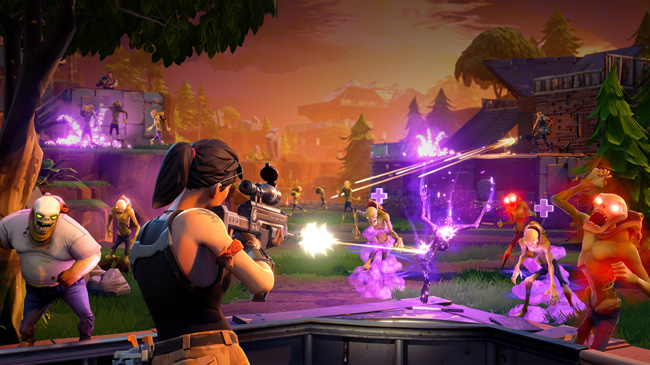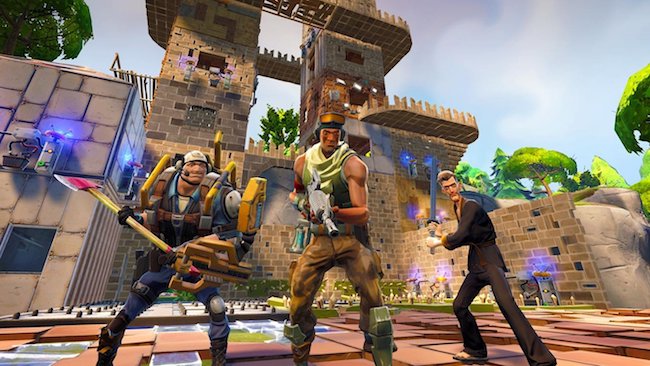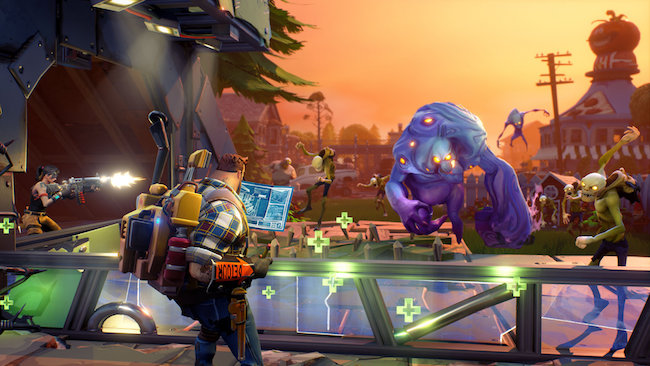
First revealed in 2011, Fortnite is a co-op survival shooter and defence building game from Epic Games and People Can Fly where you and your teammates must fight to survive against hordes of monsters. During development, Epic Games founder Tim Sweeney described the game as “Minecraft meets Left 4 Dead,” and finally we’re able to see for ourselves if it can live up to such an ambitious claim. It certainly has been a long time coming, but the game is officially available as a “paid early access title” with plans to go free-to-play at some point in 2018. It’s an unusual release plan, and while I’d say Fortnite has launched as what could be considered to complete game, we anticipate there will be substantial changes to how it plays over the coming year and have chosen to hold back our full review until that time.

The story begins one night when a purple storm covers the earth and takes out most of the human race. The remaining survivors have no choice but to fight off waves of creatures that aim to destroy everything in their path. As the new commander, you’re in charge of recruiting heroes, helping survivors, collecting resources and must build defence forts to fend off all threats. Right off the bat, Fortnite feels like a solid third-person shooter with a playful tutorial that covers the basics of the control system, combat, the building mechanics, as well as the cast of characters, including heroes, defenders and survivors.
Who you’ll play as during missions are characters called heroes; each of which has their own class. There are four classes currently, Soldier, Ninja, Constructor and Outlander, and, as expected, each class comes equipped with a set of special abilities. Ninjas are experts in melee combat, Soldiers are skilful with ranged weapons, Outlanders have abilities geared towards finding loot and harvesting, while Constructors have advanced skills in building. As you complete missions, you’ll earn points to level up each of your heroes and raise their stats and add new skills.

So far, I’m really enjoying Fortnite’s building system. It’s simple to use, and the interface is easy to manage when constructing walls, ceilings, stairs, doors and traps. It’s especially handy when you have a crowd of monsters on your back, and you can quickly create a spiky floor trap to slow them right down. With pickaxe in hand, you can also harvest building materials by chopping down trees for wood, hacking cars for metal, clubbing walls for stone, and many other materials designed for construction. Another building feature is crafting, which is a mechanic that allows you to create items at any time. After completing zone objectives, you are rewarded with new schematic which will help you to create weapons and ammunition.
The combat system is fantastic and plays a lot better than many of its contemporaries with responsive weapons and swift controls. The melee attacks and ranged weapons offer good feedback and feel satisfying when taking out enemies. Fortnite introduces a few mission types from defending a location to helping stranded survivors. Each mission still retains the same core mechanic of collecting resources and shooting down enemies, but, despite these seemly repetitive tasks, there is enough variety in the missions that it doesn’t get too tiresome.
The game also looks great as it uses an art style that is very colourful and lively. It kind of reminds me a bit of Sunset Overdrive or perhaps even a DreamWorks film, which suits the tone of the game perfectly. Each character has unique qualities and appearances, while the enemy design is fairly standard but matches the environment. The voice acting is top notch and the dialogue well-written with lots of entertaining interactions between all the characters.

Currently, player progression is structured around players completing quests to claim loot at the end of each mission. Loot comes in the form of llama piñatas, which you’ll smash open to unlock new heroes, schematics, survivors, and experience chips (which are used to upgrade weapons, traps, and other items). This is also where the free-to-play model comes into play as there are many types of llamas, but most require you to spend “V-Bucks” (an in-game currency you have to buy with your own money) if you want to claim rarer and more rewarding loot.
If you looked at the release model for Fortnite and scratched your head in confusion, I wouldn’t blame you. It’s needlessly convoluted for an early access game, not to mention it can get really expensive. The standard “Founder’s Pack” is basically just the core game, whereas the other “editions” come with increasingly more content, such as weapons, heroes, loot, and more. A big problem I have with the game currently is the reward progression for those players who decide invest time instead of money isn’t very good at all. You could fairly call it “pay-to-win,” as the game will only offer you the best loot if you’re willing to spend real money. As a free-to-play game, it would be easier to stomach, but as a paid release right now, it stings. Not everybody wants to indulge in microtransactions, let alone can afford it, so I found it unfortunate the game isn’t giving anything back to its dedicated, long-term players.
Fortnite is a well-made and engrossing co-op survival shooter with charming visuals, action-packed gameplay, a good mix of classes, and simple building mechanics. On the downside, though, the microtransaction model is questionable, and the imbalance of the reward system for avid players really needs some work. Despite being an early access title, it’s basically a complete game and one that I’ve really enjoyed so far. However, as it’s no doubt going to evolve over the coming months and eventually go free-to-play in 2018, I’d recommend waiting until that time as the current in-game economy just doesn’t gel well with having to pay for the game outright.











